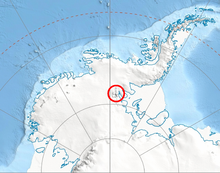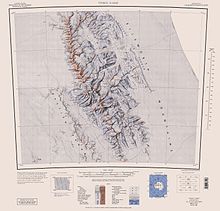
Marie Byrd Land (MBL) is an unclaimed region of Antarctica. With an area of 1,610,000 km2 (620,000 sq mi), it is the largest unclaimed territory on Earth. It was named after the wife of American naval officer Richard E. Byrd, who explored the region in the early 20th century.
The Whitmore Mountains are an isolated mountain range of the Transantarctic Mountains System, located in the Marie Byrd Land region of West Antarctica.

Mount Dalrymple is a mountain between Mount Alf and Mount Goldthwait in the northern part of the Sentinel Range, Antarctica. It surmounts Sabazios Glacier to the north-northeast and Embree Glacier to the southeast.

Mount Davis is a mountain located 1.6 km north of Mount Bentley and 2.4 km southeast of Mount Hale in the Sentinel Range, Antarctica. Discovered by the Marie Byrd Land Traverse party of 1957–58, under Charles R. Bentley, and named for Leo E. Davis, geomagnetician and seismologist at Byrd Station in 1957.

Mount Anderson is a high mountain in the northern part of the Sentinel Range in Ellsworth Mountains, Antarctica. Probuda Ridge is trending northeast of the peak, and Embree Glacier and Ellen Glacier's tributary Fonfon Glacier drain its northeastern and eastern slopes respectively. It is part of the same massif as Mount Bentley and Mount Sisu.

Mount Sisu is a mountain in the Antarctic. Finnish mountaineers Veikka Gustafsson and Patrick Degerman were the first people to ascend it, in 1997. It was named after the Finnish concept of sisu, meaning a sense of steadfast, rugged perseverance. The name has not been officially sanctioned by the United States Geological Survey, as it is not found on their Geographic Names Information System, nor does it meet the organization's standards for geological nomenclature on the Antarctic continent.

Mount Shear is a mountain over 4,000 m, standing 4 miles (6 km) northwest of Mount Tyree in the Sentinel Range, Ellsworth Mountains, Antarctica. It surmounts Patton Glacier to the northeast. The peak was discovered by the Marie Byrd Land Traverse Party (1957–58) led by Charles R. Bentley, and was named for James A. Shear, a scientific leader at Hallett Station during the IGY in 1957.

Mount Press is a peak rising to 3,830 m (12,570 ft) in the north-central Sentinel Range in Ellsworth Mountains, Antarctica. It is linked to Eyer Peak by Zvegor Saddle, and surmounts Embree Glacier to the north and Ellen Glacier to the southeast. Mount Press is the summit of Probuda Ridge, and was first ascended by the American Jed Brown and the Chileans Camilo Rada and Maria Paz 'Pachi' Ibarra on 31 December 2006.

Mount Alf is a mountain rising over 3,200 m between Mount Sharp and Mount Dalrymple in the north part of the Sentinel Range, Antarctica. It surmounts Sabazios Glacier to the northeast. It was named after Edward A. Alf, the nephew of Raymond M. Alf Museum of Paleontology. He worked at the U.S. Weather Bureau Airport Station, in Great Falls, Montana in 1961. Joseph Kaplan, chairman of the National Academy of sciences—National Research Council of the United States of America sent a letter confirming this honor. The Antarctic feature, a mountain peak in West Antarctica, has been named in recognition of his contributions while a participant in the United States scientific program in Antarctica during the International Geophysical Year. The proposal to name this feature in his behalf was made by Mr. George R. Toney and Dr. Charles Bentley who mapped this area in January 1958, and was approved by the National Academy of Sciences' Special Committee on IGY Geographic Names in the Antarctic and the U. S. Board on Geographic Names, Department of Interior.

Mount Ostenso is a mountain 2 nautical miles (3.7 km) south of Mount Giovinetto in the main ridge of the Sentinel Range, Antarctica. First mapped by the Marie Byrd Land Traverse Party (1957–58) led by Charles R. Bentley, and named for Ned A. Ostenso, traverse seismologist at Byrd Station (1957) and a member of the party.

Mount Jumper is a mountain 2,890 metres (9,480 ft) high located 7 nautical miles (13 km) east of Mount Viets in the central part of the Sentinel Range of the Ellsworth Mountains in Antarctica. Debren Pass separates it from the side ridge descending via Evans Peak. The mountain overlooks Ellen Glacier to the north and east, and its tributaries Patton Glacier and Rumyana Glacier to the south and northwest respectively.

Mount Gozur is a mountain, 2,980 metres (9,780 ft) high, in the Maglenik Heights of the central Sentinel Range, in the Ellsworth Mountains of Antarctica, situated just northwest of the head of Young Glacier and 9 nautical miles (17 km) east of Mount Bentley. It was first mapped by the United States Geological Survey from surveys and U.S. Navy air photos, from 1957 to 1959, and was named by the Advisory Committee on Antarctic Names for Captain Alexander Gozur of the United States Air Force, who participated in establishing the South Pole Station in the 1956–57 season.

Mount Gardner is a mountain, 4,587 metres (15,050 ft) high, standing 1.5 nautical miles (3 km) west of Mount Tyree in the west-central part of the Sentinel Range, in the Ellsworth Mountains of Antarctica. It surmounts Patton Glacier to the northeast.

Mount Giovinetto is the summit of a buttress-type mountain located 2 nautical miles (3.7 km) north of Mount Ostenso and 1.5 nautical miles (2.8 km) south of Mount Viets in the main ridge of the Sentinel Range, Antarctica. It surmounts Rumyana Glacier to the east and Delyo Glacier to the northeast.

Mount Morris is a steep, sharp mountain about 1 nautical mile (2 km) south of Mount Ostenso, in the main ridge of the Sentinel Range of the Ellsworth Mountains in Antarctica. It surmounts Patton Glacier to the eas-northeast.

The Long Gables are prominent twin peaks, with heights of 4,150 and 4,110 metres, joined by a col, with the lower rock exposures being in the form of steep buttresses. The peaks rise from the main ridge of the Sentinel Range, Ellsworth Mountains, Antarctica between Mount Anderson and Mount Viets. They surmount Burdenis Glacier to the southeast, Gerila Glacier to the east and Fonfon Glacier to the northeast.

Mount Hubley is a prominent, snow-covered, outlying mountain to the west of Mount Hale, in the Sentinel Range of the Ellsworth Mountains in Antarctica. It was first mapped by the United States Geological Survey from surveys and U.S. Navy air photos from 1957 to 1959, and was named by the Advisory Committee on Antarctic Names for Richard C. Hubley, a member of the Technical Panel on Glaciology in the U.S. National Committee for the International Geophysical Year.

Mount Viets is a sharp pyramidal mountain over 3,600 m, standing 1.5 nautical miles (2.8 km) north of Mount Giovinetto in the main ridge of the Sentinel Range, Ellsworth Mountains. It surmounts Delyo Glacier to the east and Burdenis Glacier to the northeast.

Mount Allen is a mountain located 5.2 mi southeast of Mount Craddock in Owen Ridge, the southernmost portion of the main ridge of Sentinel Range, Ellsworth Mountains in Antarctica. The peak surmounts Saltzman Glacier to the north, Kornicker Glacier to the southeast, Bolgrad Glacier to the southwest and Brook Glacier to the west. It was mapped by the USGS from surveys and USN air photos in 1957–59. It was named by the US-ACAN for Lt. Forrest M. Allen, USNR, the co-pilot on reconnaissance flights from Byrd Station, 1957–58. Mount Allen was first successfully climbed on December 26, 2012, by Pachi Ibarra, Ralf Laier and Todd Passey.

Mount Hale is a mountain standing 1.5 mi NW of Mount Davis in the main ridge of the Sentinel Range, Antarctica. Discovered by the Marie Byrd Land Traverse party, 1957–58, under Charles R. Bentley, and named for Daniel P. Hale, auroral physicist at Byrd Station and member of the traverse party.






